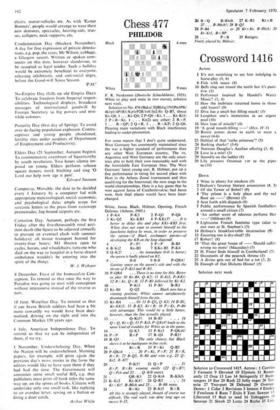Chess 477
PHILIDOR
F. R. Neukomm (Deutsche Schachbliitter, 1921). White to play and mate in two moves; solution next week.
Solution to No. 476 (Baksi 3QBblq/1N1Pn1 PR/ 4k1 p1/4P1R I / K pIrP2B/ I n6/5p2/8): Q-B7, threat Kt-Q8. 1 . Kt-Q4; 2 P-Q8=Kt. 1 . Kt-Ktl; 2 Px B=Kt. 1 . . . Kt(2) any other; 2 R x P.
1 . . . R xQP; 2 Qx1t.: 1 . R xKP; 2 Q-Q6. Pleasing main variations with Black interference leading to under-promotion.
For some reason that I don't quite understand, West Germany has consistently maintained since the war a higher standard of performance than any other West European country. The us, Argentina and West Germany are the only coun- tries able to hold their own reasonably well with the formidable East European bloc. The West Germans' latest young star, R. Hiibner, put up a fine performance in tieing for second place with Hort in the Athens Zonal tournament and thus qualifying for the Interzonal, the next stage in the world championships. Here is a key game that he won against Jansa of Czechoslovakia; had Jansa won, their final places would have been inter- changed.
White, Jansa. Black, Hilbner. Opening, French Defence. (Athens, 1969.) 1 P-K4 P-K3 2 P-Q3 P-Q4
3 Kt-Q2 Kt-KB3 4 P-KKt3? It is better to delay this and play KKt-KB3. first. White does not want to commit himself to the fianchetto before he must, in order to preserve the option—if Black exchanges pawns—of developing the KB on the long diagonal.
PxP! 5 PxP B-B4 6 B-Kt2 Kt-B3 7 KKt-B3 P-K4
8 Q-K2? . . . An immediate 0-0 is better; the queen is badly placed on K2.
8 . . . 0-0 9 0-0 . P-QR4! Gaining space on the queen's side and with the threat of P-Kt3 and B-R3.
10 P-QR4 There is no time for this. Better to play 10 Kt-B4, Q-K2; 11 B-Kt5, P-KR3;
12 B x Kt, Q x B; 13 P-B3 followed by 10-K3.
10 . . . P-Kt3 11 P-B3 B-R3
12 Kt-B4 Q-Q2 ... Black now has a winning position; White cannot satisfactorily disentangle himself front the pin.
13 Kt-R4 ... Or 13 R-Q1, Q-K3; 14 B-B1, Kt-K1(15; 15 B-K3, Kt x B; 16 Px Kt, P-B4 with advantage. This would be a little better, however, than the line actually played.
13 . . . Q-Kt5! 14 B-B3 . . . 74 Q x Q, Kt x Q; 15 P-Kt3,P-Q104! leads to the same kind of troubles for White as in the game.
14 . . . Q-K3 15 P-Kt3 P-QKt4!
16 PxP BxP 17 R-Q1 P-R5!
18 R-Q5 . . . The only chance, but Black shows it to be inadequate in fine style.
18 . . . Kt x R 19 P x Kt Q-B3
20 P-QKt4 . . . 20. Px Kt, PxP; 21 Rx R, R x R; 22 B-Q5, R-R8 and wins e.g. 23 Q- 1K12, R-R7/ 20 . . P-K5! .21 QxP . 21 B x P, Bx Kt winning easily (22 Q x B??, Q x Pch and 23 . . . Q-Kt8 male).
21 . . . QR-K1 22 Q-Kt4 R-K8ch
23 K-Kt2 Kt-K4! 24 Q-R5 . . . 24 Kt x Kt?. B-B8ch and 2S . . B-86 mate. B x Kt . 25 B-Kt5 R x R All this is strongly played, though of course not difficult. The real work was done long ago on moves 9-17.
26 B xQ B-Blch 27 K-R1 Kt x B 27 . . . B-R6ch?; 28 B-Q1
28 P-B4 . . or 28 Kt x Kt, B-R6cli; 29 Kt-Ktl, Bx
28 . . . P x B 29 Resigns. Finely played by Hubner.


































 Previous page
Previous page